| Ba'al Shem
Tov (c. 1698-1760)
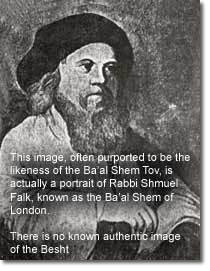 |
|
Rabbi Israel ben Eliezer is widely considered
to be the founder of the Hasidic movement, revealing himself
and assuming the name Ba’al Shem Tov (‘Master
of the Good Name’) in 1734 while living and teaching
in Tluste. It may be assumed that the many years he spent
in Tluste were influential in shaping the course of Hasidism,
described as the most popular mass-movement in Judaism
today.
While details of the Ba’al Shem Tov’s personal
life are somewhat obscure and subject to differing interpretation,
that he is an enormously important figure in Jewish history
is not disputed. |
He is arguably among the greatest Jewish figures who ever
lived, mentioned in the same breath as Maimonides, a 12th
century philosopher and scholar, and Theodor Herzl, credited
by many as the founder of modern Zionism in the late 19th
century.
The Besht (the commonly used acronym for Ba’al Shem
Tov) has been described as follows:
“There are probably more tales and legends told about
Rabbi Yisrael Ba'al Shem Tov than about any figure in Jewish
history…” (1)
“the Baal Shem Tov's influence on all religions in
the 20th century matches his enormous influence on Jewish
devotional practice in his own age.” (2)
“his teachings brought about a whole movement which
emphasized the idea of bringing God into all aspects of
one’s life, particularly through intense prayer and
joyous singing.” (3)
He emphasized “the power of each individual soul;
the concepts of love of your fellow; serving God with joy;
Divine Providence and perpetual creation.” (4)
As the photograph accompanying this article points out, there
is no authenticated image of the Ba’al Shem Tov –
the one that is commonly presented as being his likeness is
actually a portrait of Rabbi Shmuel Falk, the Ba’al
Shem of London (5).
The Besht’s connection to Tluste
is confirmed by various sources.
First, two of the rare surviving letters that he personally
signed indicate Tluste as his home or place of origin
(6);
second, there are two specific references to Tluste
in the tales of his life and deeds, depicted in Shivei
Ha-Besht: In Praise of the Baal Shem Tov
(7); and, third, his mother is buried in the Jewish
cemetery of Tluste/Tovste, where her tombstone could
be found at least until April 1944. (8)
|
|
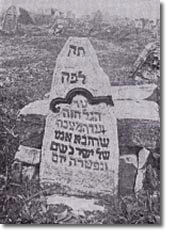 |
A brief biography
Much of the biographical information on the Ba’al Shem
Tov is derived from legendary tradition, and there is a vast
literature upon which to draw. One of the Besht’s followers
complied an anthology of 230 stories or shevahim (praises)
concerning his amazing life and works, which was published
in 1814 (9).
As the Besht himself left behind few if any of this own writings,
we are left to discern fact from fiction from what others
have written, a task that is fraught with difficulty. As Heppenheimer
notes (10),
there is a popular saying that runs: “One who believes
all the stories told about the Ba'al Shem Tov is a fool; one
who does not believe they could have occurred is an apikoros
(heretic).”
| It appears to be generally
accepted that Rav Israel was born around 1698 in the village
of Okopy (often written as Okup), in Podilia province
of what was then Poland. For ease of reference, Okopy
(48°32’ N; 26°24’ E) is situated about
5 km northwest of Chotyn, in present-day Ukraine, roughly
two-thirds of the way between Chernivtsi and Kamyanets-Podilskyy.
Curiously, despite numerous references to Okup (or Okopy)
in accounts of the Besht that I came across on the internet
while researching this article, not a single one precisely
pinpointed where this village is actually located. |
|
Where
exactly is Okup (Okopy)?
Okup has been variously described as being “near
the Dniester River” (11);
“on the Russian-Polish border” (12)
and “near Brody” (13),
which lies about 100km east of L’viv, far
from the putative location. The most specific reference
observed (in Heppenheimer) states that “Swiety
Trojcy, to give Okup its Polish name, had been founded
as a military outpost close to the Polish-Turkish
border…” (14).
more
»
|
|
According to tradition, Rav Israel’s parents –
Eliezer and Sarah – were poor and elderly, and he was
orphaned at about the age of five. He was adopted and educated
by the local community, but was said to be a non-conformist,
“preferring the solitude of the woods around his hometown,
where he could freely commune with God”(17).
Several accounts indicate that in his teens, Rav Israel worked
first as a school assistant and then as a caretaker at the
local synagogue, presumably in Okup. “At the age of
12 Israel became a helper to a schoolmaster, gathering the
children from their homes in the morning and taking them back
in the evening. On the way he taught them the synagogue hymns…”
(18).
Heppenheimer (19)
suggests a different course of events, whereby Israel left
Okup already before the age of ten, joined a group of holy
men with a mission of “rebuilding Jewish communities
from the inside”, and wandered with them through much
of the Polish kingdom, eventually settling in the town of
Tluste where, by then in his teens, he took a job as a behelfer
(assistant teacher). Encyclopedia Britannica Online (20)
presents a third alternative, positing that the Besht's birthplace
was "probably Tluste, Podolia".
Although it is widely written that Rav Israel did settle
for a time in Tluste, the chronology offered by other writers
is rather different. It is said that Israel spent time in
Brody (mentioned above, approximately 75km northwest of Ternopil,
and quite far from the Okup that Heppenheimer and others describe).
| There he married Chanah
(also written Chana or Hannah), the daughter of local
Rabbi Efraim and sister of Rabbi Gershon Kittover (21).
Some accounts (22).
suggest that this was Israel’s second marriage,
his first wife having died shortly after they married,
when he was 18 or 20. Heppenheimer (23)
claims, alternatively, that sometime around 1720 Israel
married Leah Rachel, daughter of Avraham (or Ephraim),
of Kutow (Kitov).
It is interesting to note the differing interpretations
as to why the couple left Brody. Some writers suggest
that the brother of Chanah (or Leah) considered Israel
to be ignorant, disapproved of the marriage, and was
so embarrassed that he encouraged or forced them to
move elsewhere (24).
Another suggests that Israel deliberately posed as an
ignoramus in order to hide his devotions (25).
|
|
|
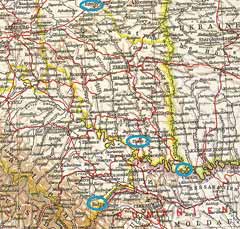 |
There seems to be general agreement that the couple moved
to the southern Carpathian mountain village of Kutty (Kitov),
situated about 60km straight line distance west of present-day
Chernivtsi. There, Israel was said to have eked out a living
digging clay and lime (26)
and his wife was said to have run an inn (27).
While living in this remote mountain area for a period of
about 10 years, Israel learned the healing properties of certain
grasses and herbs (28),
and his expertise in medicinal herbs earned him a reputation
as a “ba'al shem”. As he practiced his healing
craft he also began to preach his religious teachings. According
to Spiro: “During this time he studied with a secret
society of Jewish mystics, the Nestarim, and he eventually
became a revered rabbi. He travelled from community to community,
developing a reputation wherever he went as a spiritual holy
man and mystical healer, attracting a huge following.”
(29)
According to some interpretations of traditional legend,
Israel next moved to Tluste, where he worked as a teacher
and, on his 36th birthday (16 September 1734), revealed himself
as the Ba’al Shem Tov, marking the official birth of
the Hasidic movement (30).
For what it's worth, Buxbaum (31)
suggests that the Besht spent four years in Tluste, but that
his revelation occurred in Kitov, three months after his 36th
birthday.
Most scholars and others who buy into the notion that the
Besht was orphaned at a very young age tend to gloss over
an incontrovertible fact: that the Jewish cemetery in Tluste
was the location of his mother's gravestone, bearing 1740
as the year of her death. In other words, the Besht would
have been about 40 years old when his mother died and not
a child of five, as legend would have it. In support of the
former contention, it is probably no coincidence that, in
that same year of 1740, the Besht and his wife moved from
Tluste to the fortress town of Medzhybizh on the Bug river,
some 160 km to the northeast. One can speculate that with
the death of his mother, the Besht would no longer have had
a binding commitment to stay in Tluste; and he may have decided
the time was right to move on.
There are other anecdotes linking the Besht to Tluste (32).
A gentile neighbour is said to have provided straw for the
Besht to sit on while he prayed on a small frozen pond to
the west of the town centre. Shimshon Melzter, a poet from
Tluste, wrote a poem about a conversation between the Besht's
mother and one of his ancestors. While sipping tea, the former
is said to have lamented the fact that the young Israel was
not serious about his studies. Perhaps the Encyclopedia Britannica
Online’s contention (mentioned above) that the Besht's
birthplace was “probably Tluste” is not without
merit.
Finally, some have speculated, somewhat tenuously, that the
Besht may have lived in a house next to a small stream that
meanders through Tluste, bisecting the town's main road. In
support of this conjecture, the large modern
house presently standing on that location is reported
to have been occupied by rabbis who later served in the town.
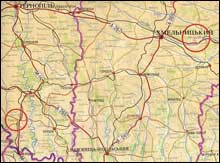 |
|
In Medzhybizh, the Besht and his wife
had a son Tzvi Hersh and a daughter Udel (or Adil).
The family lived in Miedzyboz for the last 20 years
of the Besht’s life, until his death on 22/23
May 1760. |
|
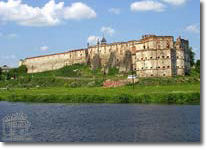
|
| |
The threads of the Besht’s life
in Miedzyboz are pulled together by Rosman (33),
who examined the town’s tax records in his critically
acclaimed dissertation (34).
The Besht's daughter, Udel, married Rabbi Yahiel Ashkenazi
and had a daugther of her own – by the name
of Feiga – who would later wed Reb Simchah (son
of Rebbe Nachman, one of the Ba'al Shem Tov's leading
disciples from nearby Horodenka). The couple had three
sons and a daughter. The most prominent of these was
Rebbe Nachman (1772-1810) who, like his great-grandfather,
spent many years in Miedzyboz before eventually moving
to Breslov (Bratslav) in the latter part of his life.
Click for a genealogy
chart showing these various family relationships.
As the current entry in Wikipedia
aptly summarises, the younger Rebbe Nachman was born
at a time when the influence of his great-grandfather
was waning, and "he breathed new life into the
Hasidic movement by combining the esoteric secrets of
Judaism (the Kabbalah) with in-depth Torah scholarship.
He attracted thousands of followers during his lifetime
and, after his death, his followers continued to regard
him as their Rebbe and did not appoint any successor.
Rebbe Nachman's teachings continue to attract and inspire
Jews the world over."
Although Rebbe Nachman and his followers became associated
with the town of Breslov, it was in Uman - further to
the east - that he spent his last days. He died there
at the age of 38, having suffered from tuberculosis
for the last three years of his life. In accordance
with his wishes, Rebbe Nachman was buried in Uman's
Jewish cemetery which soon became the site of an annual
pilgrimage for thousands of Hasidim on the occasion
of Rosh Hashana, the Jewish New Year. Severely curtailed
during the Communist era, to the point where the devout
had to visit the grave candestinely, the annual pilgrimage
resumed after the fall of communism in 1989 and has
gathered momemtum in recent years.
In September 2006, it was estimated that up to 20,000
followers would travel to Uman from within Ukraine and
abroad, requiring El Al to operate 18 special flights
and charters to channel the visitors through Kyiv and
Odessa. Click here for an online
account of the event, which appears to be taxing
Uman's capacity to host such a large influx of guests
every year.
Ironically, in the quiet town of Tluste / Tovste –
some 330 km (200 miles) to the west – where Rebbe
Nachman's great-grandfather, the Ba'al Shem Tov, founded
the Hasidic movement nearly 275 years ago, there is
no such annual pilgramage – not even the slightest
recognition that this town on the eastern fringe of
Podolia was the spiritual birthplace of Hasidism.
|
* * *
The information presented above attempts to
tease apart different accounts of Ba’al Shem Tov’s
life as interpreted through traditional legend. While the
detail and chronology may be at odds in places, the major
points that emerge seem to be broadly consistent. The Ba’al
Shem Tov spent an important period of his life in the town
of Tluste, living there for at least six years from about
1734, and solidifying his reputation as a miracle worker and
soul master. Given the Besht’s significant – arguably,
paramount – role in the emergence of the Hasidic movement
in the eighteenth century, it is reasonable to assert that
the Ba’al Shem Tov is Tluste’s most famous resident,
though this fact remains, for the time being, relatively unknown
to the outside world.
Notes:
(1) Heppenheimer, Alexander. 300 Years After His Birth the
Ba’al Shem Tov’s Legacy Lives On. The Jewish Homemaker:
https://www.homemaker.org/shvouot98/cover.html; last accessed
in early 2005 (link not available in September 2005).
(2) Robb, Christina. 1997. Book review of Reaches of Heaven,
by Isaac Bashevis Singer.
The Boston Globe Online. https://www.boston.com/globe/search/stories/nobel/1980/1980t.html;
last accessed on 3 September 2005.
(3) Spiro, Ken (Rabbi). The
Hassidic Movement; last accessed on 3 September 2005.
(4) Anonymous. Meaningful Life Center. Rabbi Israel Baal
Shem Tov (Besht) – (1698-1760). https://www.meaningfullife.com/spiritual/mystics/The_Besht.php;
last accessed on 3 September 2005.
(5) Assaf, D. pers comm. 2006.
(6) Rosman, M.J. Founder of Hasidism: A Quest for the Historical
Ba’al Shem Tov. Berkeley, University of California Press,1996.
pp. 63, 233.
(7) Ben-Amos, D. and J.R. Mintz (eds). Shivhei ha-Besht:
In praise of the Baal Shem Tov. Northvale, N.J., 1993. pp.
36, 211.
(8) International Jewish Cemetery Project: https://www.jewishgen.org/cemetery/e-europe/ukra-t.html;
last accessed on 16 August 2005; Lindenberg, G. (ed.). Sefer
Tluste. Tel Aviv, 1965. p. 38; and Milch-Avigal, S. (ed.).
Can Heaven be Void? Jerusalem, 2003. p. 232.
(9) Isaacs, Mark. Hasidic Judaism and Lutheran Pietism.
https://www.elcm.org/hasidicrelattoPietististicLutheran.html;
last accessed in early 2005 (link not available in September
2005).
(10) Heppenheimer, Alexander. 300 Years After His Birth the
Ba’al Shem Tov’s Legacy Lives On. The Jewish Homemaker:
https://www.homemaker.org/shvouot98/cover.html; last accessed
in early 2005 (link not available in September 2005).
(11) Spiro, Ken (Rabbi). The
Hassidic Movement; last accessed on 3 September 2005.
(12) Baal Shem Tov Foundation. The Biographical Rabbi Baal
Shem Tov (The Besht) 18 Elul 5458 - 6 Sivan 5520 (1698-1760).
https://www.baalshemtov.com/whowashe.htm;
last accessed on 3 September 2005.
(13) JewishGen’ ShtetLinks. Pre-19th-Century Brody:
Hasidism
https://www.shtetlinks.jewishgen.org/brody/brody.htm;
last accessed on 3 September 2005.
(14) Heppenheimer, Alexander. 300 Years After His Birth the
Ba’al Shem Tov’s Legacy Lives On. The Jewish Homemaker:
https://www.homemaker.org/shvouot98/cover.html; last accessed
in early 2005 (link not available in September 2005).
(15) Falling Rain Global Gazetteer Version 2.1
https://www.fallingrain.com/world/UP/0/Okopy.html,
last accessed on 15 April 2007.
(16) Zakharii, R. Borshchiv Town and Vicinities.
https://www.personal.ceu.hu/students/97/Roman_Zakharii/borshchiv.htm;
last accessed on 3 September 2005.
(17) Heppenheimer, Alexander. 300 Years After His Birth the
Ba’al Shem Tov’s Legacy Lives On. The Jewish Homemaker:
https://www.homemaker.org/shvouot98/cover.html; last accessed
in early 2005 (link not available in September 2005).
(18) Isaacs, Mark. Hasidic Judaism and Lutheran Pietism.
https://www.elcm.org/hasidicrelattoPietististicLutheran.html;
last accessed in early 2005 (link not available in September
2005).
(19) Heppenheimer, Alexander. 300 Years After His Birth the
Ba’al Shem Tov’s Legacy Lives On. The Jewish Homemaker:
https://www.homemaker.org/shvouot98/cover.html; last accessed
in early 2005 (link not available in September 2005).
(20) Encyclopedia Britannica Online. Ba'al Shem Tov. https://www.britannica.com/eb/article-9011579/Baal-Shem-Tov;
last accessed on 19 November 2006.
(21) Breslov Research Institute. The Breslov Movement: https://www.breslov.org/bmovement.html;
last accessed on 3 September 2005.
(22) For example, Klausner, Y. The Hasidic Rabbinate, Part
I. Rabbinic Genealogy Special Interest Group (Rav-SIG: Online
Journal), https://www.jewishgen.org/rabbinic/journal/hasidic1.htm
last accessed on 3 September 2005; and Segal, E. Hasidism.
https://www.ucalgary.ca/~elsegal/363_Transp/Orthodoxy/Hasidism.html;
last accessed on 3 September 2005.
(23) Heppenheimer, Alexander. 300 Years After His Birth the
Ba’al Shem Tov’s Legacy Lives On. The Jewish Homemaker:
https://www.homemaker.org/shvouot98/cover.html; last accessed
in early 2005 (link not available in September 2005).
(24) Klausner, Y. The Hasidic Rabbinate, Part I. Rabbinic
Genealogy Special Interest Group (Rav-SIG: Online Journal),
https://www.jewishgen.org/Rabbinic/journal/hasidic1.htm,
last accessed on 3 September 2005; and Anonymous. Spiritual
Stars of the Golden Age. Baal Shem Tov. https://www.saieditor.com/stars/baal.html;
last accessed on 9 February 2010.
(25) Breslov Research Institute. The Breslov Movement:
https://www.breslov.org/bmovement.html; last accessed on
3 September 2005; and Heppenheimer, Alexander. 300 Years After
His Birth the Ba’al Shem Tov’s Legacy Lives On.
The Jewish Homemaker: https://www.homemaker.org/shvouot98/cover.html;
last accessed in early 2005 (link not available in September
2005).
(26) Isaacs, Mark. Hasidic Judaism and Lutheran Pietism.
https://www.elcm.org/hasidicrelattoPietististicLutheran.html;
last accessed in early 2005 (link not available in September
2005).
(27) Buxbaum, Yitzak. The Light and Fire of the Baal Shem
Tov. New York, Continuum International Publishing Group, 2005.
p.82.
(28) Isaacs, Mark. Hasidic Judaism and Lutheran Pietism.
https://www.elcm.org/hasidicrelattoPietististicLutheran.html;
last accessed in early 2005 (link not available in September
2005).
(29) Spiro, Ken (Rabbi). The
Hassidic Movement; last accessed on 3 September 2005.
(30) Heppenheimer, Alexander. 300 Years After His Birth the
Ba’al Shem Tov’s Legacy Lives On. The Jewish Homemaker:
https://www.homemaker.org/shvouot98/cover.html; last accessed
in early 2005 (link not available in September 2005).
(31) Buxbaum, Yitzak. The Light and Fire of the Baal Shem
Tov. New York, Continuum International Publishing Group, 2005.
pp. 77-81, 113, 120.
(32) Sommer, U. pers comm. 2008.
(33) Rosman, M.J. Founder of Hasidism: A Quest for the Historical
Ba’al Shem Tov. Berkeley, University of California Press,
1996.
(34) Lazaroff, Tovah. In Search of the Real Ba’al Shem
Tov. The Jerusalem Post – Internet Edition, 14 December
2000. https://www.jpost.com/Editions/2000/12/14/Features/Features.17392.html;
last accessed in 2004.

|

